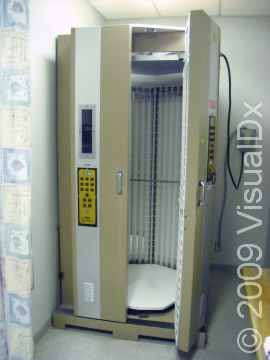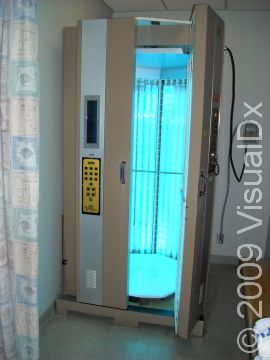Phototherapy
Phototherapy uses ultraviolet (UV) light under medical supervision to treat certain skin diseases. Depending on the skin disorder being treated, phototherapy is delivered for several seconds to minutes per session, usually 2–3 times per week. Phototherapy is predominantly an office-based procedure, but home treatment regimens with portable light boxes can also be prescribed to carefully selected patients. Phototherapy can be used alone or in combination with topical or systemic medications, depending on the indications. Common types of UV light treatment include:
- Broadband UVB light therapy (280–320 nanometer wavelengths)
- Narrow band UVB light treatments (311 nanometer wavelength only)
- UVA light therapy (320–400 nanometer wavelengths of light)
- PUVA (320–400 nanometer wavelengths of light). This is UVA light therapy combined with an oral light-sensitizing medication known as psoralen.
Who's At Risk?
Because UV light can suppress the immune system, phototherapy is used to decrease the inflammation associated with skin conditions responsive to this therapy.
Skin disorders that can be treated with phototherapy include the following:
- Psoriasis
- Eczema
- Vitiligo
- Itching
- Cutaneous T-cell lymphoma
Poor candidates for UV light and PUVA therapy include people who are pregnant or breast-feeding or with the following:
- Allergy to sunlight
- History of skin conditions that worsen with UV light exposure (eg, lupus, types of porphyria)
- History of skin cancers
- Exposure in the past to substances or procedures that would increase the risk of skin cancers (eg, arsenic or radiation therapy)
- Liver disease (for patients taking psoralen)
- Eye conditions that may be worsened by phototoxicity
- Inability to stand
Signs & Symptoms
Patients should apply sunblock to uninvolved areas that may become exposed to UV light during the treatment session. Telling your doctor of any moisturizers and topical medications used on a regular basis might help maximize therapy, as some may affect the outcome of the treatment in a positive or negative way. For PUVA therapy, the patient takes a light-sensitizing medication (psoralen) 1–2 hours before UV treatment.
Phototherapy treatments are usually performed at a doctor’s office or a psoriasis center. With the patient undressed to expose the affected areas and spare unaffected areas from the side effects of UV light, special goggles are used to prevent the risk of UV-induced cataracts. Additionally, genitalia are protected to minimize the risk of skin cancer, which is more problematic in that area. The patient stands in front of a light box lined with vertically oriented fluorescent UV lamps.
Each therapy session is supervised by a physician experienced in phototherapy treatments. The first few therapy sessions are brief in duration and are gradually increased once the patient’s response to therapy is assessed. Patients with lighter skin start with shorter times of exposure compared to people with darker skin.
Self-Care Guidelines
A patient undergoing phototherapy must be made aware of the significant time commitment necessary to achieve clear skin. Phototherapy sessions are usually scheduled 2–5 times per week, depending on the skin condition and severity. It may take as many as 30 sessions to completely clear psoriasis lesions. Once the skin is clear, phototherapy treatments can be stopped or can be continued on a routine “maintenance” basis.
Patients with chronic skin conditions who become more experienced with the procedure and who are comfortable in self-administering light therapy can be prescribed a light-therapy unit appropriate for its use at home, following their physicians’ recommendations to keep their skin condition under control.
After having treatment, patients should wear protective clothing and sunscreen on a daily basis. Those treated with PUVA therapy should also wear sunglasses to prevent eye damage as a result of the psoralen-induced light sensitivity.
Treatments
Depending on the condition to be treated, topical, oral, or injectable medication might be used.
When to Seek Medical Care
- Increased risk of skin cancer development with long-term therapy
- Nausea
- Itching
- Redness of the skin
- Freckling
- Cataracts
- Skin aging changes
Last modified on October 5th, 2022 at 7:47 pm

Not sure what to look for?
Try our new Rash and Skin Condition Finder

